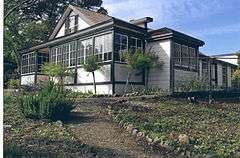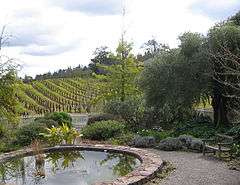Jack London State Historic Park
|
Jack London Ranch | |
 | |
  | |
| Nearest city | Glen Ellen, California |
|---|---|
| Coordinates | 38°21′2″N 122°32′35″W / 38.35056°N 122.54306°WCoordinates: 38°21′2″N 122°32′35″W / 38.35056°N 122.54306°W |
| Area | 47.5 acres (192,000 m2)[1] |
| NRHP Reference # | 66000240 |
| CHISL # | 743 |
| Significant dates | |
| Added to NRHP | October 15, 1966[2] |
| Designated NHL | December 29, 1962[3] |
| Designated CHISL | July 5, 1960[4] |
Jack London State Historic Park, also known as Jack London Home and Ranch, is a California State Historic Park near Glen Ellen, California, United States, situated on the eastern slope of Sonoma Mountain. It includes the ruins of a house burned a few months before Jack London and family were to move in, a cottage in which they had lived, another house built later, and the graves of Jack London and his wife. The property is both a California Historical Landmark and a National Historic Landmark.
The Jack London home, called the Wolf House, is a sizable stone structure, which was destroyed by fire and whose ruins are visible within the state park property. The sloping terrain of the park has a considerable occurrence of Goulding clay loam soils, particularly in the lower reaches.[5]
History
Jack London State Historic Park was occupied by a winery called Kohler & Frohling. Jack London purchased the property when it was abandoned in 1905 with hopes of becoming a rancher. While London was there, he expanded the small cottage to 3,000 square feet (279 square meters) and converted the stone house next to it into a study where London would write his works. Between 1909 and 1911, London bought more land to expand his ranch.
In 1910, he began work on his mansion on his ranch called the Wolf House. Jack and Charmian spent more than $80,000 in pre-World War I money on the house. It was to be 15,000 square feet (1,393 square meters), have custom made furniture and decorations, and feature a reflection pool stocked with mountain bass. On August 22, 1913, while the Londons were away from their ranch, they received word that their new mansion was on fire. By the time they got there the building was completely overtaken by the fire, and it was too late to save the house.
London was devastated after the fire burnt down the house that he never got to live in. This put London in debt and forced him to literally work to death, as he tried to earn enough money to run his ranch and have a good lifestyle.
On November 22, 1916, London died of a cause that is still disputed today. He wished to be cremated and have his ashes interred on the property. He also stated that he wanted to be buried near the pioneer children on a hill underneath a rock from the Wolf House, which was just down the road.
After London died, his wife Charmian inherited the property. During that time she built a house on the land called the House of Happy Walls, which is a smaller version of the Wolf House. Charmian lived there until her death in 1955. In her will, she wanted the house she built to become a museum in honor of her husband. This became the start of the Jack London State Historic Park, which opened four years later to the public in 1959. Today it's an attraction to many Jack London fans and people who enjoy the nature of the property. On May 13, 2011, California State Parks officials announced plans to close the Jack London State Historic Park to the public due to the state's fiscal crisis.[6]
Park features

Winery Cottage
The Winery Cottage was the main living quarters throughout London's time on the ranch, and the location where many of his visitors stayed. London bought it in 1911 and expanded it later that year. London further expanded by adding a west wing to the cottage, which served as a study where he wrote many of his stories. London died in this cottage, on the sunporch, on November 22, 1916.
House of Happy Walls

Charmian London constructed The House of Happy Walls in 1919, in memory of Jack. It's a smaller and a more formal version of the Wolf House, and much of its furniture was originally intended for use in the Wolf House. Charmian lived in The House of Happy Walls until her death in 1955, and instructed that the house be used after her death as a museum for Jack London. Today it serves as the visitor center and a museum for Jack London State Historic Park.

Wolf House
The Wolf House began construction in 1910 and was to be 15,000 square feet (1,393 square meters) and to include only materials native to the area, a reflection pool stocked with mountain bass, and custom made furniture. The house was nearly complete in 1913, but before the Londons got to move in, the house burnt down. The ruins still stand today.[7]
Jack and Charmian London's grave

Jack and Charmian London are both buried on the property not far from the Wolf House. Jack's funeral took place on November 26, 1916, attended only by close friends, relatives, and workers of the property. In accordance with his wishes, he was cremated and buried next to some pioneer children, under a rock that belonged to the Wolf House. After Charmian's death in 1955, she was also cremated and then buried with her husband in the same simple spot that her husband chose.
Other
Jack and Charmian London's property was declared a California Historical Landmark in 1960 and a National Historic Landmark in 1962.[1][3][4]
The park has been in the process of being entrusted to the Valley of the Moon Natural History Association (VMNHA) due to the statewide budget problems experienced in 2012. The California State Park system is breaking new ground by allowing private non-profit groups to operate State Parks slated for closure.[8]
The Winery ruins next to the cottage were host to the Transcendence Theatre Company's benefit performance on Saturday, October 1, 2011, for the VMNHA.[9] The Theatre Company planned to partner with the VMNHA to produce a concert series in summer of 2012 which would also benefit the Annadel, Sugarloaf Ridge, and Jack London State Parks.
In popular culture
The site was featured in the 2010 novel The Lost Hero by Rick Riordan. According to the novel, the Wolf House is where the Roman demigods are claimed by Lupa.
See also
References
- 1 2 Cecil McKithan (October 7, 1977). "National Register of Historic Places Inventory-Nomination: Jack London Home and Ranch / Jack London State Historic Park" (pdf). National Park Service. and Accompanying two photos, from 1977 (32 KB)
- ↑ National Park Service (2007-01-23). "National Register Information System". National Register of Historic Places. National Park Service.
- 1 2 "Jack London Ranch". National Historic Landmark summary listing. National Park Service. Retrieved 2008-07-07.
- 1 2 "Jack London State Historic Park". Office of Historic Preservation, California State Parks. Retrieved 2012-10-15.
- ↑ Soil Survey, Sonoma County, California, U.S. Department of Agriculture, Soil Conservation Service, United States Government Printing Office, Washington DC, May 1972
- ↑ Van Oot, Tory. "Editor" Check
|url=value (help). California Officials Announce Closure of 70 State Parks. California Alert, Sacramento Bee. Retrieved May 13, 2011. - ↑ Hayes, Gregory W.; Atkinson, Matt (2010). Jack London's Wolf House. Glen Ellen, California: Falcon Books and Valley of the Moon Natural History Association. ISBN 9780615426006.
- ↑ http://www.kqed.org/a/forum/R201109070900
- ↑ http://www.sonomanews.com/News-2011/Nonprofits-hope-to-save-Jack-London/
Further reading
- Levine, Elisa Stancil (2015). "'Images of America' series". Jack London State Historic Park. Mount Pleasant, South Carolina: Arcadia Publishing. ISBN 978-1467132626.
External links
| Wikimedia Commons has media related to Jack London State Historic Park. |
- State of California official site for Jack London State Historic Park
- Jack London State Historic Park Website
- Howser, Huell (December 10, 1994). "Jack London – California's Gold (502)". California's Gold. Chapman University Huell Howser Archive.
- Jack London at Find a Grave

